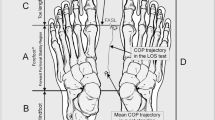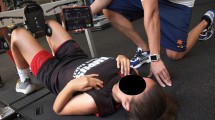Abstract
Background and aims: The most common cause of accidental injury and death in people over age 65 results from impacts associated with falling. Balance impaired older adults have poorer balance control than healthy young adults or healthy older adults. Lack of sufficient lower extremity strength and inability to rapidly produce muscle force may contribute to diminished balance control in the elderly. This study evaluated the effect of a 10-week high intensity strength- training program targeting key lower extremity muscles for the purpose of improving postural control in frail older adults. Methods: Thirteen experimental and fourteen control subjects, all balance impaired older adults were evaluated in response to unexpected platform perturbations that simulated slips. Results: Following strength training the experimental group was significantly stronger than the control group. Mean ankle moments improved in the experimental group following strength training during forward sway (Right: p=0.067, Left: p=0.009) and backward sway (Right: p=0.031, Left: p=0.058). For the backward sway condition the ankle rate of torque production increased significantly in the experimental group (Right: p=0.016, Left: p=0.031). Conclusions: Enhancement of lower extremity strength contributed to improvements in balance stability demonstrated by greater ankle force production, in response to balance threats.
Similar content being viewed by others
References
Gehlsen GM, Whaley MH. Falls in the elderly: Part I, gait. Arch Phys Med Rehabil 1990; 71: 735–8.
Donald IP, Bulpitt CJ. The prognosis of falls in elderly people living at home. Age Aging 1999; 28: 121–5.
Nashner LM, Woollacott M. The organization of rapid postural adjustments of standing humans: An experimental conceptual model. In Talbott RE, Huymphrey DR, eds. Raven Press, NY: Posture and Movement, 1979.
Woollacott MH, Shumway-Cook A, Nashner LM. Aging and posture control: Changes in sensory organization and muscular coordination. Int J Aging Hum Dev 1986; 23: 97–114.
Manchester D, Woollacott M, Zederbauer-Hylton N, Marin O. Visual, vestibular and somatosensory contributions to balance control in older adult. J Gerontol 1989; 44: M118–27.
Horak F, Nashner L. Central programming of postural movements: adaptation to altered support surface configuration. J Neurophysiol 1986; 55: 1369–81.
Tinetti ME, Williams TF, Mayewski R. Fall risk index for elderly patients based on number of chronic disabilities. Am J Med 1986; 80: 429–34.
Whipple RH, Wolfson LI, Amerman P. The relationship of knee and ankle weakness to falls in nursing home residents. J Am Geriatr Soc 1987; 35: 329–32.
Nevitt MC, Cummings SR, Hudes ES. Risk factors for injurious falls: A prospective study. J Gerontol 1991; M164-70.
Fiatarone MA, O’Neill EF, Ryan ND, et al. Exercise training and nutritional supply for physical frailty in very elderly people. N Engl J Med 1994; 330: 1170–5.
Häkkinen K, Kraemer WJ, Newton RU, Alen M. Changes in electromyographic activity, muscle fibre and force production characteristics during heavy resistance/power strength training in middle-aged and older men and women. Acta Physiol Scand 2001; 171: 51–62.
Shumway-Cook A, Baldwin P, Polissar N, Gruber WM. Predicting the probability for falls in community dwelling older adults. Phys Ther 1997; 77: 812–9.
Shumway-Cook A, Brauer S, Woollacott MH. Predicting the probability for falls in community dwelling older adults using the up and go test. Phys Ther 2000; 80: 896–903.
Buchner DM, Cress ME, de Lateur BJ, et al. The effect of strength and endurance training on gait, balance, fall risk, and health services use in community-living older adults. J Gerontol 1997; 52: M218–24.
Berg K, Wood-Dauphinee S, Williams JI. The balance scale: Reliability assessment with elderly residents and patients with an acute stroke. Scand J Rehab Med 1995; 27: 27–36.
Podsiadlo D, Richardson S. The timed “Up & Go”: A test of basic functional mobility for frail elderly persons. J Am Geriatr Soc 1991; 39: 142–8.
General Principles of Exercise Prescription. In Franklin B, ed. American College of Sports Medicine Guidelines for Exercise Testing and Prescription, 6th ed. Philadelphia, PA: Lippincott Williams and Wilkins, 2000: 137–64.
Lombardi VP. Beginning weight training. Bubuque, IA: WC Brown, 1989.
Mayhew JL, Prinster JL, Ware JS, Zimmer DL, Arabas JR, Bemben MG. Muscular endurance repetitions to predict bench press strength in men of different training levels. J Sports Med Phys Fitness 1995; 35: 108–13.
Sipilä S, Elorinne M, Alen M, Suominen H, Kovanen V. Effects of strength and endurance training on muscle fibre characteristics in elderly women. Clin Physiol 1997; 17: 459–74.
Brauer, S, Woollacott M, Shumway-Cook A. The interacting effects of cognitive demand and recovery of postural stability in balance-impaired elderly persons. J Gerontol 2001; 56: M489–96.
Bothner KE, Jensen JL, How do non-muscular torques contribute to the kinetics of postural recovery following a support surface translation? J Biomech 2001; 34: 245–50.
Winter DA, ed. Biomechanics and Motor Control of Human Movement, 2nd ed. Wiley-Interscience Publications, NY, 1990, 56–7.
Enoka RM, ed. Neuromechanics of Human Movement. Champaign IL: Human Kinetics, 2002: 70.
Pavol MJ, Owings TM, Foley KT, Grabiner MD. Influence of lower extremity strength of healthy older adults on the outcome of an induced trip. J Am Geriatr Soc 2002; 50: 256–62.
Lord SR, Ward JA, Williams P, Anstey KJ. Physiological factors associated with falls in older community-dwelling women. J Am Geriatr Soc 1994; 42: 1110–7.
Studenski SA, Duncan PW, Chandler JM. Postural responses and effector factors in persons with unexplained falls: Results and methodologic issues. J Am Geriatr Soc 1991; 39: 229–34.
Wolfson L, Judge J, Whipple R, King M. Strength is a major factor in balance, gait and the occurrence of falls. J Gerontol 1995; 50A: 64–7.
Nevitt MC, Cummings SR, Kidd S, Black D. Risk factors for recurrent nonsyncopal falls. JAMA 1989; 261: 2663–8.
Thelen DG, Schultz AB, Alexander NB, Ashton-Miller JA. Effects of age on rapid ankle torque development. J Gerontol 1996; 51A: M226–32.
Thelen DG, Ashton-Miller JA, Schultz AB, Alexander NB. Do neural factors underlie age differences in rapid ankle torque development? J Am Geriatr Soc 1996; 44: 804–8.
Robinovitch SN, Heller B, Lui A, Cortez J. Effect of strength and speed of torque development on balance recovery with the ankle strategy. J Neurophysiol 2002; 88: 613–20.
DeVita P, Hortobagyi T. Age causes a redistribution of joint torques and powers during gait. J Appl Physiol 2000; 88: 1804–11.
Connelly DM, Vandervoort AA. Effect of isokinetic strength training on concentric and eccentric torque development in the ankle dorsiflexors of older adults. J Gerontol 2000; 55A: B465–72.
Hall CD, Woollacott MH, Jensen JL. Age-related changes in rate and magnitude of ankle torque development: Implications for balance control. J Gerontol 1999; 54A: M507–13.
Gu MJ, Schultz AB, Shepard NT, Alexander NB. Postural control in young and elderly adults when stance is perturbed: Dynamics. J Biomech 1996; 29: 319–29.
Runge CF, Shupert CL, Horak FB, Zajac FE. Ankle and hip postural strategies defined by joint torques. Gait Posture 1999; 10: 161–70.
Moritani T, DeVries HA. Neural factors versus hypertrophy in the time course of muscle strength gain. Am J Phys Med 1979; 58: 115–30.
Enoka RM. Neural strategies in the control of muscle force. Muscle Nerve Suppl 1997; 5: S66–9.
Sale DG. Neural adaptation to resistance training. Med Sci Sports Med 1988; 20: S135–45.
Horak F, Diener HC, Nashner LM. Influence of central set on human postural responses. J Neurophysiol 1989; 62: 841–53.
Nashner LM. Adapting reflexes controlling the human posture. Exp Brain Res 1976; 26: 59–72.
Nashner LM. Fixed patterns of rapid postural responses among leg muscle during stance. Exp Brain Res 1977; 30: 13–24.
Author information
Authors and Affiliations
Corresponding author
Rights and permissions
About this article
Cite this article
Hess, J.A., Woollacott, M. & Shivitz, N. Ankle force and rate of force production increase following high intensity strength training in frail older adults. Aging Clin Exp Res 18, 107–115 (2006). https://doi.org/10.1007/BF03327425
Received:
Accepted:
Published:
Issue Date:
DOI: https://doi.org/10.1007/BF03327425




